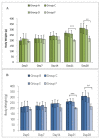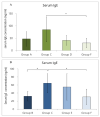Probiotics' Efficacy in Preventing Asthmatic Allergic Reaction Induced by Air Particles: An Animal Study
- PMID: 36558377
- PMCID: PMC9784300
- DOI: 10.3390/nu14245219
Probiotics' Efficacy in Preventing Asthmatic Allergic Reaction Induced by Air Particles: An Animal Study
Abstract
Global air pollution and diesel exhaust particles (DEPs) generated by intratracheal instillation aggravate asthma. In this study, we evaluated the effect of probiotics via tracheal- or oral-route administration on allergies or asthma. We continuously perfused rats daily, using the oral and tracheal routes, with approximately 106-108 CFU probiotics, for 4 weeks. During this period, we used OVA-sensitized rats to build the asthma models. We orally or intratracheally administered Lactobacillus paracasei 33 (LP33) to the rats, which reduced the number of total inflammatory cells, lymphocytes, and eosinophils in the bronchoalveolar-lavage fluid, the IgE concentration, and the cytokine levels of TH2 cells, but we found no significant difference in the cytokine levels of TH1 cells. LP33 can be used to prevent asthmatic allergic reactions induced by aerosol particles. Nevertheless, the dosage form or use of LP33 needs to be adjusted to reduce the irritation of lung tissues, which may produce lesions of the trachea. We observed that DEP dosage can alleviate emphysema, and that LP33 has a substantial effect on improving or slowing allergic asthma.
Keywords: allergic disease; asthma; diesel exhaust particles; ovalbumin; probiotics.
Conflict of interest statement
We declare there are no conflicts of interest.
Figures









Similar articles
-
Siraitia grosvenorii residual extract attenuates ovalbumin-induced lung inflammation by down-regulating IL-4, IL-5, IL-13, IL-17, and MUC5AC expression in mice.Phytomedicine. 2019 Aug;61:152835. doi: 10.1016/j.phymed.2019.152835. Epub 2019 Jan 16. Phytomedicine. 2019. PMID: 31035047
-
Supplementation with heat-inactivated Lacticaseibacillus paracasei K47 ameliorates allergic asthma in mice by regulating the Th1/Th2 balance.Benef Microbes. 2022 Feb 28;13(1):73-82. doi: 10.3920/BM2021.0035. Epub 2022 Jan 24. Benef Microbes. 2022. PMID: 35067214
-
Oral administration of Clostridium butyricum CGMCC0313-1 reduces ovalbumin-induced allergic airway inflammation in mice.Respirology. 2017 Jul;22(5):898-904. doi: 10.1111/resp.12985. Epub 2017 Jan 25. Respirology. 2017. PMID: 28122397
-
Oral administration of Lactobacillus plantarum CQPC11 attenuated the airway inflammation in an ovalbumin (OVA)-induced Balb/c mouse model of asthma.J Food Biochem. 2022 Feb;46(2):e14036. doi: 10.1111/jfbc.14036. Epub 2022 Jan 3. J Food Biochem. 2022. PMID: 34981513
-
Oral treatment with probiotics reduces allergic symptoms in ovalbumin-sensitized mice: a bacterial strain comparative study.Int Arch Allergy Immunol. 2010;151(2):107-17. doi: 10.1159/000236000. Epub 2009 Sep 15. Int Arch Allergy Immunol. 2010. PMID: 19752564
Cited by
-
Can probiotics be used in the prevention and treatment of bronchial asthma?Pharmacol Rep. 2024 Aug;76(4):740-753. doi: 10.1007/s43440-024-00618-0. Epub 2024 Jul 1. Pharmacol Rep. 2024. PMID: 38951480 Free PMC article. Review.
-
The Link Between Dysbiosis, Inflammation, Oxidative Stress, and Asthma-The Role of Probiotics, Prebiotics, and Antioxidants.Nutrients. 2024 Dec 24;17(1):16. doi: 10.3390/nu17010016. Nutrients. 2024. PMID: 39796449 Free PMC article. Review.
-
Study of the Relationship between Mucosal Immunity and Commensal Microbiota: A Bibliometric Analysis.Nutrients. 2023 May 20;15(10):2398. doi: 10.3390/nu15102398. Nutrients. 2023. PMID: 37242281 Free PMC article. Review.
References
-
- Kim B.G., Lee P.H., Lee S.H., Kim Y.E., Shin M.Y., Kang Y., Bae S.H., Kim M.J., Rhim T., Park C.S., et al. Long-Term effects of diesel exhaust particles on airway inflammation and remodeling in a mouse model. Allergy Asthma Immunol. Res. 2016;3:246–256. doi: 10.4168/aair.2016.8.3.246. - DOI - PMC - PubMed
MeSH terms
Substances
LinkOut - more resources
Full Text Sources
Medical

